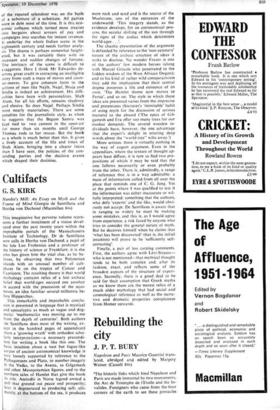Cultifacts
G. S. KIRK
Hamlet's Mill: An Essay on Myth and the Frame of Mind Giorgio de Santillana and Hertha von Dechend (Macmillan 84s)
This imaginative but perverse volume repre- sents a further instalment of a vision devel- oped over the past twenty years within the improbable portals of the Massachusetts institute of Technology. Dr de Santillana now calls in Hertha von Dechend, a pupil of the late Leo Frobenius and a professor of the history of science at Frankfurt; it is she who has given him the vital clue, as he be- lieves, by observing that two Polynesian islands with an unusual number of cult- places lie on the tropics of Cancer and Capricorn. The resulting theory is that world mythology contains relics of a lost archaic belief that world-ages succeed one another in accord with the precession of the equi- noxes, an idea familiar several millennia be- fore Hipparchus.
This remarkable and improbable conclu- sion is presented in language that is mystical and apocalyptic as much as vague and dog- matic: 'mathematics was moving up to me from the depth of centuries'. Both authors (de Santillana does most of the writing, ex- cept in the hundred pages of appendices) share a 'growing wrath' with orthodox scho- larly interpretations—a necessary precondi- tion for writing a book like this one. The basic intuition about a vast but fugue-like Corpus of ancient astronomical knowledge is very loosely supported by reference to the Pythagoreans and Plato, to number-iinagery in the Vedas, to the Avesta, to Gilgamesh and other Mesopotamian figures, and to the northern tales of Hamlet that give the book its title. Amlodhi in Norse legend owned a Mill that ground out peace and prosperity; later it degenerated to producing salt; ulti- mately, at the bottom of the sea, it produces mere rock and sand and is the source of the Maelstrom, one of the entrances of the underworld: 'This imagery stands, as the evidence develops, for an astronomical pro- cess, the secular shifting of the sun through the signs of the zodiac which determines world-ages ...'.
The chaotic-presentation of the argument is defended by reference to the 'non-catenary' nature of the archaic structure of ideas it seeks to disclose. No wonder Frazer is one of the authors' few modern heroes (along with Marcel Griaule who penetrated to the hidden wisdom of the West African Dogon); and to his kind of rather wild comparativism they add the implication that their central dogma possesses a life and existence of its own: 'The Hamlet theme now moves to Persia', and so on. The style in which these ideas are presented varies from the imprecise and pretentious (Socrates's 'inimitable' habit of using myth for the discussion of serious matters) to the absurd ('The epics of Gil- gamesh and Era offer too many trees for our modest demands. The several wooden in- dividuals have, however, the one advantage that the expert's delight in uttering deep words about the "world-tree" wilts away.') More serious. there is virtually nothing in the way of cogent argument. Even in the appendices, where the texture of thought ap- pears least diffuse, it is rare to find two pro- positions of which it may be said that the one follows necessarily or even probably from the other. There is, admittedly, a range of reference that is in a way admirable: a mass of information culled from all over the place that reminds one of C. G. Jung. Yet at the points where I was qualified to test it the information was either inaccurate or wil- fully interpreted: something that the authors, who defy 'experts' and the like, would obvi- ously not accept. De Santillana is aware that in ranging so widely he must be making some mistakes, and this is, as I would agree from experience, a risk faced by anyone who tries to consider the general nature of myth. But he deceives himself when he claims that 'what has been discovered' (that is, the initial intuition) will prove to be 'sufficiently self- correcting'.
Finally, a pair of less carping comments. First, the authors agree with Levi-Strauss- who is not mentioned—that mythical thought tends to be both complex and, after its fashion, exact, and reflects some of the broadest aspects of the structure of experi- ence. Secondly, there is a good deal to be said for their assumption that Greek myths as we know them are the merest relics of a much older mythology that had social and cosmological reference as well as the narra- tive and dramatic properties conspicuous from Homer onwards.






































 Previous page
Previous page